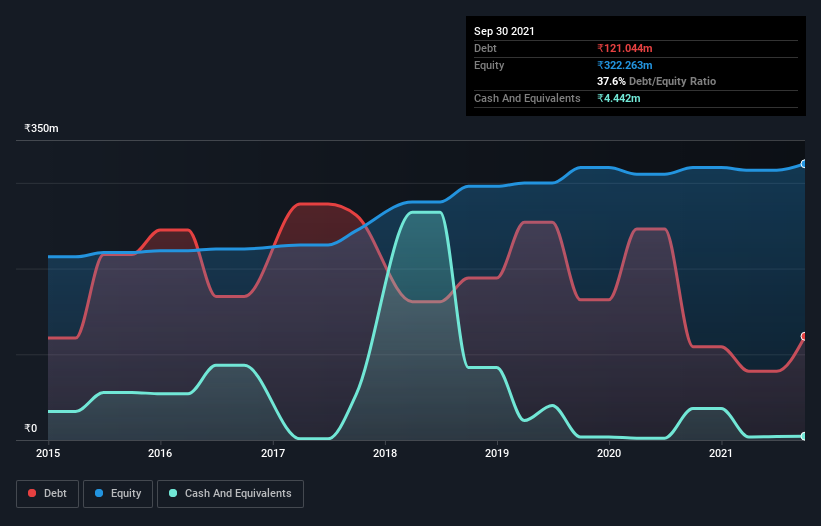
Warren Buffett famously said, 'Volatility is far from synonymous with risk.' So it might be obvious that you need to consider debt, when you think about how risky any given stock is, because too much debt can sink a company. As with many other companies B.C. Power Controls Limited (NSE:BCP) makes use of debt. But the real question is whether this debt is making the company risky.
Why Does Debt Bring Risk?
Debt assists a business until the business has trouble paying it off, either with new capital or with free cash flow. Part and parcel of capitalism is the process of 'creative destruction' where failed businesses are mercilessly liquidated by their bankers. However, a more frequent (but still costly) occurrence is where a company must issue shares at bargain-basement prices, permanently diluting shareholders, just to shore up its balance sheet. Of course, the upside of debt is that it often represents cheap capital, especially when it replaces dilution in a company with the ability to reinvest at high rates of return. The first step when considering a company's debt levels is to consider its cash and debt together.
View our latest analysis for B.C. Power Controls
How Much Debt Does B.C. Power Controls Carry?
You can click the graphic below for the historical numbers, but it shows that as of September 2021 B.C. Power Controls had ₹121.0m of debt, an increase on ₹108.9m, over one year. On the flip side, it has ₹4.44m in cash leading to net debt of about ₹116.6m.

How Strong Is B.C. Power Controls' Balance Sheet?
According to the balance sheet data, B.C. Power Controls had liabilities of ₹360.2m due within 12 months, but no longer term liabilities. Offsetting this, it had ₹4.44m in cash and ₹288.2m in receivables that were due within 12 months. So its liabilities total ₹67.5m more than the combination of its cash and short-term receivables.
This deficit isn't so bad because B.C. Power Controls is worth ₹267.0m, and thus could probably raise enough capital to shore up its balance sheet, if the need arose. But we definitely want to keep our eyes open to indications that its debt is bringing too much risk.
We measure a company's debt load relative to its earnings power by looking at its net debt divided by its earnings before interest, tax, depreciation, and amortization (EBITDA) and by calculating how easily its earnings before interest and tax (EBIT) cover its interest expense (interest cover). This way, we consider both the absolute quantum of the debt, as well as the interest rates paid on it.
With net debt to EBITDA of 2.9 B.C. Power Controls has a fairly noticeable amount of debt. On the plus side, its EBIT was 8.3 times its interest expense, and its net debt to EBITDA, was quite high, at 2.9. Notably, B.C. Power Controls's EBIT launched higher than Elon Musk, gaining a whopping 5,065% on last year. When analysing debt levels, the balance sheet is the obvious place to start. But it is B.C. Power Controls's earnings that will influence how the balance sheet holds up in the future. So when considering debt, it's definitely worth looking at the earnings trend. Click here for an interactive snapshot.
Finally, a business needs free cash flow to pay off debt; accounting profits just don't cut it. So it's worth checking how much of that EBIT is backed by free cash flow. Over the most recent three years, B.C. Power Controls recorded free cash flow worth 51% of its EBIT, which is around normal, given free cash flow excludes interest and tax. This cold hard cash means it can reduce its debt when it wants to.
Our View
B.C. Power Controls's EBIT growth rate suggests it can handle its debt as easily as Cristiano Ronaldo could score a goal against an under 14's goalkeeper. But truth be told we feel its net debt to EBITDA does undermine this impression a bit. All these things considered, it appears that B.C. Power Controls can comfortably handle its current debt levels. Of course, while this leverage can enhance returns on equity, it does bring more risk, so it's worth keeping an eye on this one. There's no doubt that we learn most about debt from the balance sheet. However, not all investment risk resides within the balance sheet - far from it. To that end, you should be aware of the 1 warning sign we've spotted with B.C. Power Controls .
Of course, if you're the type of investor who prefers buying stocks without the burden of debt, then don't hesitate to discover our exclusive list of net cash growth stocks, today.
Valuation is complex, but we're here to simplify it.
Discover if B.C. Power Controls might be undervalued or overvalued with our detailed analysis, featuring fair value estimates, potential risks, dividends, insider trades, and its financial condition.
Access Free AnalysisHave feedback on this article? Concerned about the content? Get in touch with us directly. Alternatively, email editorial-team (at) simplywallst.com.
This article by Simply Wall St is general in nature. We provide commentary based on historical data and analyst forecasts only using an unbiased methodology and our articles are not intended to be financial advice. It does not constitute a recommendation to buy or sell any stock, and does not take account of your objectives, or your financial situation. We aim to bring you long-term focused analysis driven by fundamental data. Note that our analysis may not factor in the latest price-sensitive company announcements or qualitative material. Simply Wall St has no position in any stocks mentioned.
About NSEI:BCP
B.C. Power Controls
Engages in trading of ferrous and non-ferrous metals in India.
Flawless balance sheet and fair value.
Market Insights
Community Narratives




